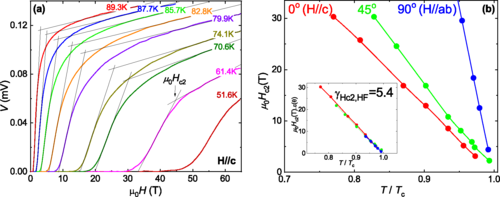
Intrinsic anisotropy versus effective pinning anisotropy in YBa2Cu3O7 thin films and nanocomposites
Authors: E. Bartolomé, F. Vallés, A. Palau, V. Rouco, N. Pompeo, F. F. Balakirev, B. Maiorov, L. Civale, T. Puig, X. Obradors and E. Silva
Phys. Rev. B 100, 054502 (2019)
Abstract: The intrinsic and effective anisotropies, both in the liquid and solid vortex regimes, of YBa2Cu3O7 (YBCO) pristine and nanocomposite thin films have been investigated. Angular resistivity measurements under varying fields and temperatures were performed to characterize the intrinsic vs effective anisotropy of samples in the regime of long-range vortex displacements. The effective anisotropy γeff was determined from the scaling of the irreversibility line, applying the Blatter approach developed for uniaxial anisotropic superconductors. Resistive measurements in flux flow were utilized, in addition to Hc2 measurements in ultrahigh-fields, to determine the intrinsic anisotropy mass γ, enabling the study of a large number of samples with varied nanoparticle compositions. In order to access the intrinsic anisotropy in the vortex solid phase, complex impedance measurements at high microwave frequencies were performed, allowing us to access the flux-flow intrinsic anisotropy in the regime of very short vortex oscillations within the pinning potential wells. Results show that while the effective anisotropy γeff decays as the nanoparticles-induced nanostrain in the YBCO films increases, the intrinsic anisotropy γ (determined both in dc and at microwave frequency) remains unaltered.
